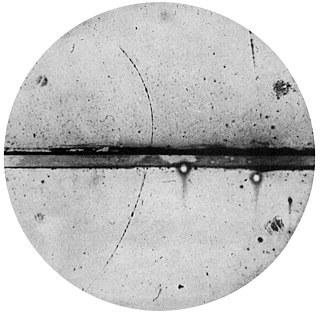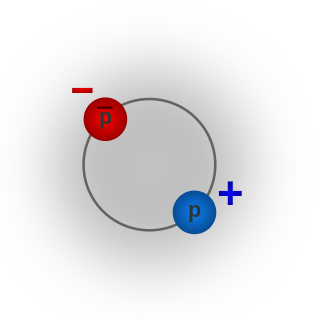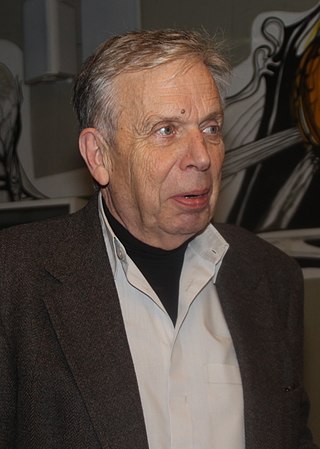
In modern physics, antimatter is defined as matter composed of the antiparticles of the corresponding particles in "ordinary" matter, and can be thought of as matter with reversed charge, parity, and time, known as CPT reversal. Antimatter occurs in natural processes like cosmic ray collisions and some types of radioactive decay, but only a tiny fraction of these have successfully been bound together in experiments to form antiatoms. Minuscule numbers of antiparticles can be generated at particle accelerators; however, total artificial production has been only a few nanograms. No macroscopic amount of antimatter has ever been assembled due to the extreme cost and difficulty of production and handling. Nonetheless, antimatter is an essential component of widely-available applications related to beta decay, such as positron emission tomography, radiation therapy, and industrial imaging.

Antihydrogen is the antimatter counterpart of hydrogen. Whereas the common hydrogen atom is composed of an electron and proton, the antihydrogen atom is made up of a positron and antiproton. Scientists hope that studying antihydrogen may shed light on the question of why there is more matter than antimatter in the observable universe, known as the baryon asymmetry problem. Antihydrogen is produced artificially in particle accelerators.

The antiproton,
p
, is the antiparticle of the proton. Antiprotons are stable, but they are typically short-lived, since any collision with a proton will cause both particles to be annihilated in a burst of energy.

Samuel Chao Chung Ting is an American physicist who, with Burton Richter, received the Nobel Prize in 1976 for discovering the subatomic J/ψ particle. More recently he has been the principal investigator in research conducted with the Alpha Magnetic Spectrometer, a device installed on the International Space Station in 2011.
ATHENA, also known as the AD-1 experiment, was an antimatter research project at the Antiproton Decelerator at CERN, Geneva. In August 2002, it was the first experiment to produce 50,000 low-energy antihydrogen atoms, as reported in Nature. In 2005, ATHENA was disbanded and many of the former members of the research team worked on the subsequent ALPHA experiment and AEgIS experiment.

Protonium, also known as antiprotonic hydrogen, is a type of exotic atom in which a proton and an antiproton orbit each other. Since protonium is a bound system of a particle and its corresponding antiparticle, it is an example of a type of exotic atom called an onium.
The Antihydrogen Trap (ATRAP) collaboration at the Antiproton Decelerator facility at CERN, Geneva, is responsible for the AD-2 experiment. It is a continuation of the TRAP collaboration, which started taking data for the TRAP experiment in 1985. The TRAP experiment pioneered cold antiprotons, cold positrons, and first made the ingredients of cold antihydrogen to interact. Later ATRAP members pioneered accurate hydrogen spectroscopy and observed the first hot antihydrogen atoms.
This is a timeline of subatomic particle discoveries, including all particles thus far discovered which appear to be elementary given the best available evidence. It also includes the discovery of composite particles and antiparticles that were of particular historical importance.

The gravitational interaction of antimatter with matter or antimatter has been observed by physicists. As was the consensus among physicists previously, it was experimentally confirmed that gravity attracts both matter and antimatter at the same rate within experimental error.
Estia Joseph Eichten, is an American theoretical physicist, of the Fermi National Accelerator Laboratory (Fermilab). He received his Ph.D. in 1972 from the MIT Center for Theoretical Physics, where he was a student of Roman Jackiw's, and was associate professor of physics at Harvard before joining the Fermilab Theoretical Physics Department in 1982.
Gerald Gabrielse is an American physicist. He is the Board of Trustees Professor of Physics and director of the Center for Fundamental Physics at Northwestern University, and Emeritus George Vasmer Leverett Professor of Physics at Harvard University. He is primarily known for his experiments trapping and investigating antimatter, measuring the electron g-factor, and measuring the electron electric dipole moment. He has been described as "a leader in super-precise measurements of fundamental particles and the study of anti-matter."

The Antiproton Decelerator (AD) is a storage ring at the CERN laboratory near Geneva. It was built from the Antiproton Collector (AC) to be a successor to the Low Energy Antiproton Ring (LEAR) and started operation in the year 2000. Antiprotons are created by impinging a proton beam from the Proton Synchrotron on a metal target. The AD decelerates the resultant antiprotons to an energy of 5.3 MeV, which are then ejected to one of several connected experiments.

The Low Energy Anti-Proton Ring (LEAR) was a particle accelerator at CERN which operated from 1982 until 1996. The ring was designed to decelerate and store antiprotons, to study the properties of antimatter and to create atoms of antihydrogen. Antiprotons for the ring were created by the CERN Proton Synchrotron via the Antiproton Collector and the Antiproton Accumulator (AA). The creation of at least nine atoms of antihydrogen were confirmed by the PS210 experiment in 1995.

Walter Oelert is a professor at the Juelich Research Center in Germany.

Fermilab E-906/SeaQuest is a particle physics experiment which will use Drell–Yan process to measure the contributions of antiquarks to the structure of the proton or neutron and how this structure is modified when the proton or neutron is included within an atomic nucleus.
High-precision experiments could reveal small previously unseen differences between the behavior of matter and antimatter. This prospect is appealing to physicists because it may show that nature is not Lorentz symmetric.
Recycling antimatter pertains to recycling antiprotons and antihydrogen atoms.

The Antihydrogen Laser Physics Apparatus (ALPHA), also known as AD-5, is an experiment at CERN's Antiproton Decelerator, designed to trap antihydrogen in a magnetic trap in order to study its atomic spectra. The ultimate goal of the experiment is to test CPT symmetry through comparing the respective spectra of hydrogen and antihydrogen. Scientists taking part in ALPHA include former members of the ATHENA experiment (AD-1), the first to produce cold antihydrogen in 2002.
AEgIS, AD-6, is an experiment at the Antiproton Decelerator facility at CERN. Its primary goal is to measure directly the effect of Earth's gravitational field on antihydrogen atoms with significant precision. Indirect bounds that assume the validity of, for example, the universality of free fall, the Weak Equivalence Principle or CPT symmetry also in the case of antimatter constrain an anomalous gravitational behavior to a level where only precision measurements can provide answers. Vice versa, antimatter experiments with sufficient precision are essential to validate these fundamental assumptions. AEgIS was originally proposed in 2007. Construction of the main apparatus was completed in 2012. Since 2014, two laser systems with tunable wavelengths and synchronized to the nanosecond for specific atomic excitation have been successfully commissioned.

Stefan Ulmer is a particle physicist, professor of Physics at Heinrich Heine University Düsseldorf and chief scientist at the Ulmer Fundamental Symmetries Laboratory, RIKEN, Tokyo. He is the founder and the spokesperson of the BASE experiment (AD-8) at the Antiproton Decelerator facility at CERN, Geneva. Stefan Ulmer is well known for his contributions to improving Penning trap techniques and precision measurements on antimatter. He is the first person to observe spin transitions with a single trapped proton as well as single spin transitions with a single trapped antiproton, a significant achievement towards a precision measurement of the antiproton magnetic moment.












